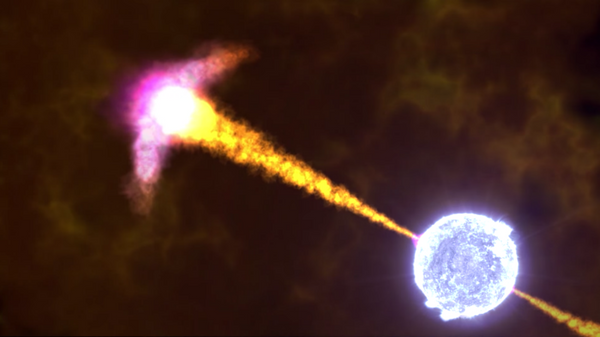Alien lifeforms and human space travellers of the distant future beware: being too close to a powerful gamma-ray burst produced by the collision of two neutron stars won’t just kill you –it will fry your DNA, Ohio State University astrophysicist Dr. Paul Sutter has warned.
In an article for LiveScience, the academic explains that while astrophysicists previously believed that gamma-ray bursts were dangerous “only if you were in the narrow path of one of the jets coming from the explosion”, new data compiled by a pair of Danish scientists appears to show that “these eruptions are bad news all around and may send deadly rays at a far wider angle than previously thought.”
Short bursts of gamma-ray radiation, resulting from the collision of distant neutron stars (i.e. the collapsed, immensely dense cores of giant stars) are created as beams of matter and energy which is tightly wound up and launched up and away from the stars’ cores, visible “as giant, brief searchlights racing away from the collision.”
“When those searchlights happen to point at Earth, we get a pulse of gamma-rays,” Sutter explained.
Previously, it was believed that because these jets of energy are relatively narrow, and they’re not dangerous to lifeforms if not observed head-on.
However, “it turns out that jets form and move away from the site of the neutron star merger in a messy, complicated way,” the astrophysicist added. “Gas clouds twist and tangle up on each other, and the flows of radiation and material away from the central black hole” (resulting from the collision) “don’t come in a neat and orderly line. The result is utter, destructive chaos."
In a recent study, Dr. Markus Ahlers and Lea Halser, a pair of astrophysicists from the University of Copenhagen, explored the behaviour of these gas clouds, discovering that occasionally, the clouds collide with one another, producing shockwaves which Sutter noted could then accelerate “and power their own sets of radiation and high-energy particles, known as cosmic rays.”
When combined with other particles, these rays can decay into neutrinos – an extremely small subatomic particle which interacts with weak subatomic forces and gravity.
According to Sutter, “the neutrinos themselves are a sign that ferocious, deadly nuclear reactions are happening farther away from the centre of the jets. We don’t yet know exactly how far the danger zone extends, but better safe than sorry. So, in summary: just don’t go anywhere near colliding neutron stars,” the scientist concludes.
First observed in the mid-1960s by space-based satellites built to monitor covert nuclear weapons tests on Earth, gamma-ray bursts were first detected by Earth-based observers only in January of this year, when scientists observing the most powerful gamma-ray burst ever recorded. The flash was so powerful that it was thought to have released more energy in the space of mere seconds than our Sun will create over its entire 10-billion-year lifespan. The burst was calculated to have originated some 5 billion light years from Earth.



